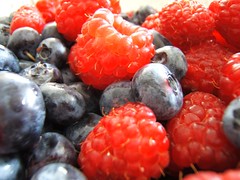Phytochemicals And The Health Value Of Colors
Mother Nature has generously supplied the plant world with thousands of bioactive chemicals, in turn giving protection to assure health and regeneration of the species. In each edible plant are dozens, if not hundreds, of phytochemicals with health benefits that transfer to us through our diet.
A simple way to grasp what phytochemicals do is to understand why plants have colors in the first place. Colorful chemicals can be described as pigments in two main classes: phenolics and carotenoids.

Phenolic Pigments
Plant colors of blue, purple, black and red belong to the pigment class called phenolics (or polyphenols), which includes several thousand individual chemicals across the plant world.
Although phenolics may be grouped in as many as 11 subclasses, each with hundreds of chemicals, those known best in public media are the flavonoids found in colorful edible plants like berries. A principal flavonoid subgroup that is common in dark berries is the anthocyanins (anthos = flower, cyanin = blue, Greek). Anthocyanins give the brightest colors to plants, including the blue of blueberries, black of blackberries, red of cherries or rose petals, and purple of prunes and eggplant.
Pigments provide two general functions to plants. Via their scent, flavor, and color, pigments serve to attract pollinators and assure continuation of the species. Secondly, they act as a defensive shell of acidic protectors guarding against bacteria, viruses, fungi and other pests. This category includes antioxidant roles necessary to neutralize the effects of constant exposure to the sun, ultraviolet radiation and production of free radicals during photosynthesis.
Following digestion from eating pigmented foods like berries, phenolics distribute throughout the body's water compartments. This includes the inside of cells where oxidative reactions are occurring second by second throughout life. Phenolics (and carotenoids below) are the antioxidants that neutralize oxidation reactions from free radicals that can damage cell structures and contribute to disease and aging.
Simply stated, humans can increase their defenses against disease by eating colorful plants. Preliminary evidence for this benefit comes from a host of research studies on animals and in limited human clinical trials. Theses studies show positive results by phenolics against:
•Cancer •Cardiovascular disease •Thrombosis (blood clots) •Inflammation •Diabetes
Phenolics appearing in public media over recent years include:
•Proanthocyanidins (anti-cancer effect from grape seeds) •Resveratrol (protective effect against cardiovascular disease from red grapes and dark wines) •Anthocyanins (protection against brain damage following stroke from blueberries) •Chlorogenic acid (reduction of high blood pressure from strawberries) •Ferulic acid (cancer prevention from black raspberries)
Carotenoids
In plants that are red, orange, yellow or green are a smaller family of pigments called the carotenoids. These are the pigments associated with the vivid colors of corn, carrots, pumpkins, tomatoes and spinach. Even though green plants have a predominance of chlorophyll – a green pigment – carotenoids are ever present (though masked by chlorophyll). An example of this effect occurs in spinach. Even though it is a dark green vegetable, spinach contains high levels of a yellow carotenoid called lutein.
Other carotenoids now seen in consumer products like vitamins and supplements include:
•Beta-carotene •Lycopene •Zeaxanthin (“zee-a-zan-thin”)
Carotenoids have two characteristics of particular health value to us. First, they tend to dissolve best in lipids and so are concentrated in fatty parts of human cells (like membranes, nuclear envelopes and the sheaths of nerves close to critical functions of these cell components). Second, carotenoids typically have numerous double-bonds between carbon atoms, a highly effective source of electrons needed in antioxidation processes.
Simply for the above reason, carotenoids are thought to be more powerful dietary antioxidants than phenolics. With carotenoids in cell lipids and phenolics in cell water, phytochemicals from a diet of colorful plants act in concert to protect our organs from potential damage by radical oxygen and nitrogen species.
In ongoing basic research on animals, carotenoids have been linked to broad health benefits including:
•Eye diseases •Cardiovascular diseases •Cancer •Psoriasis •Inflammation •Viral infections
Summary of health benefits: Enrich your dietary content of phenolics and carotenoids by eating a variety of the most brightly colored vegetables and fruits!
Reading
* Heber D, What Color is Your Diet?, 2001, HarperCollins, New York. * Joseph JA, Nadeau DA, Underwood A. The Color Code, 2002, Hyperion, New York. * Lee J, Koo N, Min DB. Reactive oxygen species, aging, and antioxidative nutraceuticals. Comprehen Rev Food Sci and Food Safety 3:21-33, 2004.
Copyright 2006 Berry Health Inc.
About The Author: A scientist, author and expert on cardiovascular and brain physiology, Dr. Paul Gross has done extensive research on the brain, bones and antioxidants. Gross is also founder of Berry Health Inc, a developer of nutritional, berry-based supplements. For more information, visit http://www.berrywiseonline.com
For Hundreds more great articles visit our
Article Archives - Directory
Categories: Diet Plan, Diet Program



